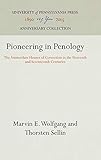Pioneering in Penology : The Amsterdam Houses of Correction in the Sixteenth and Seventeenth Centuries / Marvin E. Wolfgang.
Material type: TextSeries: Anniversary CollectionPublisher: Philadelphia : University of Pennsylvania Press, [2016]Copyright date: ©1944Edition: Reprint 2016Description: 1 online resource (136 p.)Content type:
TextSeries: Anniversary CollectionPublisher: Philadelphia : University of Pennsylvania Press, [2016]Copyright date: ©1944Edition: Reprint 2016Description: 1 online resource (136 p.)Content type: - 9781512806380
- 9781512806397
- 364
- HV8532.N2
- online - DeGruyter
- Issued also in print.
| Item type | Current library | Call number | URL | Status | Notes | Barcode | |
|---|---|---|---|---|---|---|---|
 eBook
eBook
|
Biblioteca "Angelicum" Pont. Univ. S.Tommaso d'Aquino Nuvola online | online - DeGruyter (Browse shelf(Opens below)) | Online access | Not for loan (Accesso limitato) | Accesso per gli utenti autorizzati / Access for authorized users | (dgr)9781512806397 |
Frontmatter -- Preface -- Contents -- Illustrations -- I. Punishments in Old Amsterdam -- II. The Wellsprings of Reform -- III. Plans and Proposals -- IV. The Rasphuis and Its Administration -- V. The Prisoners -- VI. The Labor Program -- VII. Welfare and Discipline -- VIII. The Rasphuis and Its Visitors -- IX. The "Private" Section -- X. The Spinhuis -- XI. The Imitators -- Bibliography -- Index
restricted access online access with authorization star
http://purl.org/coar/access_right/c_16ec
From the PrefaceIn the story of punishment, the institutions described in this monograph hold a significant place, yet their role in shaping the history of prisons has not hitherto been explored by any American or English historian of institutions. In vain do we look for even a mention of them in works like George Ives' A History of Penal Methods or in the older pioneer writings of E. C. and F. H. Wines. With one or two exceptions, even the many textbooks of criminology published in the United States in the last two decades ignore them. This is understandable when we consider that except for brief and cursory references in rather inaccessible Continental works of the eighteenth century, the "rediscovery" of the Amsterdam houses of correction did not occur until 1898, when Robert von Hippel published his splendid article about them in the Zeitschrift für die gesamte Strafrechtswissenschaft.Hippel established once for all the contribution of the Dutch municipalities of the late sixteenth and early seventeenth centuries to the rise of correctional imprisonment. It is largely to Hippel's study, which came to the author's notice nearly twenty years ago, that he owes an abiding interest in the history of punishment. Many scholars abroad were equally inspired by it, and a number of monographic studies of local German penal institutions by Hippel's own students at Göttingen resulted from it. Hallema's excellent researches into the history of the Dutch houses of correction might never have been made without the stimulus of Hippel's investigations.Were it not for the wealth of new data uncovered in the last forty years and the absence of any adequate description of the Amsterdam houses of correction in the English language, this monograph might appear to be a mere threshing of old straw. The reasons just offered are believed sufficient justification, however, for writing their story anew. It has been a pleasant PREFACE task even though the author has been unable to do full justice to it. Perhaps everyone who attempts to seize a portion of the pulsating life of a past era feels the same disappointment. Nevertheless, this monograph is presented in the hope that it will prove of interest to penologists at least and will demonstrate that the history of punishment is well worth exploration.T.S.Philadelphia,April 1944
Issued also in print.
Mode of access: Internet via World Wide Web.
In English.
Description based on online resource; title from PDF title page (publisher's Web site, viewed 30. Aug 2021)


